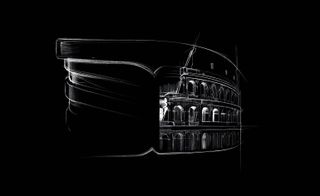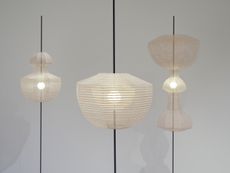In the round: Bulgari unveils Zaha Hadid’s ‘Colosseum in miniature’ at Design Miami

It may be a diminutive jewel but the Bulgari B.Zero1 ring is a distinctly grand design. Launched by the Roman jeweller in 2000, its audacious form was brilliantly informed by the architecture of the Colosseum and cast in gold, often with rich marble accents. This week, it just got a whole lot grander. The latest iteration – the majestically named B.Zero1 Design Legend – was designed in collaboration with the late, great Dame Zaha Hadid.
Marking the architect’s redesign – a sumptuous, spiralling ripple of gold – created in four related variations, Bulgari’s decision to launch it at Design Miami was a pertinent and poignant one. Hadid, of course, loved Miami and the city loved her back. Her presence was felt as she looked down upon the city in the form of a giant portrait attached to the construction site of the One Thousand Museum residential complex, due to be completed by Zaha Hadid Architects in 2018.

The B.Zero1 reflects the industrial character of its origin, its ‘pipe’-like grooves, whether fashioned in gold, ceramic or marble
To celebrate both the life of Hadid and its proud collaboration with her, Bulgari invited a prestigious group of Design Miami attendees to hear our very own design great, Wallpaper* editor-at-large Suzanne Trocmé, present a compelling rundown of design icons through the ages. Citing inventive minds such as Le Corbusier, Niemeyer, Sottsass, Paulin and Hadid, Trocmé highlighted the exact qualities that qualify as ‘legend’, whether an idea, its realization or the designer themselves.
The original B.Zero1 ring, one of the most celebrated jewellery designs of the noughties, was inventive because the material concerns shaped the design. Bulgari’s signature ‘tubogas’ (gas pipe) constructions allowed gold to be engineered so that it could flex and move. The B.Zero1 reflects the industrial character of its origin, its ‘pipe’-like grooves, whether fashioned in gold, ceramic or marble, encapsulated by two flat rings engraved with the distinct Bulgari logo.
With a nod to that early Bulgari technique, yet true to her distinct vision, Hadid freed the central bands, creating the impression of an oscillating ribbon of gold that appears to float elegantly around the finger. As Trocmé humorously pointed out, in her design of the B.Zero1 Design Legend, Hadid had, in effect, reimagined the Colosseum in miniature, in her typically magnificent style.

In her typically magnificent style, Hadid has reimagined the Colosseum in miniature for her concept

The original B.Zero1 ring, one of the most celebrated jewellery designs of the noughties, was inventive because the material concerns shaped the design
INFORMATION
For more information, visit the Bulgari website and the Zaha Hadid Architects website
Wallpaper* Newsletter
Receive our daily digest of inspiration, escapism and design stories from around the world direct to your inbox
Caragh McKay has been a contributing editor at Wallpaper* since 2014. She was previously watches & jewellery director and is currently our resident lifestyle & shopping editor. Caragh has produced exhibitions and created and edited titles for publishers including the Daily Telegraph. She regularly chairs talks for luxury houses, Van Cleef & Arpels and Cartier among them. Caragh’s current remit is cross-cultural and her recent stories include the curious tale of how Muhammad Ali met his poetic match in Robert Burns and how a Martin Scorsese film revived a forgotten Osage art.
-
 A new limited-edition Rhodes piano and Gibson doubleneck guitar aim for the stars
A new limited-edition Rhodes piano and Gibson doubleneck guitar aim for the starsThe new Rhodes Mk8 Earth Edition piano and Gibson Jimmy Page EDS-1275 Doubleneck guitar revisit classic instruments at a price
By Jonathan Bell Published
-
 The new interior design trends we spotted at Salone del Mobile 2024
The new interior design trends we spotted at Salone del Mobile 2024These are the interior design trends to look out for in 2024 and beyond, from soft upholstery to conversation pits and low dining
By Rosa Bertoli Published
-
 Tiffany & Co nods to its theatrical history with a surreal new campaign
Tiffany & Co nods to its theatrical history with a surreal new campaignTiffany & Co campaign ‘With Love, Since 1837’ sees Dan Tobin Smith and set designer Rachel Thomas create an offbeat set
By Hannah Silver Published
-
 Design Miami 2022: highlights from the fair and around town
Design Miami 2022: highlights from the fair and around townDesign Miami 2022 (30 November – 4 December) aims at ‘rebooting the roots of our relationship with nature and collective structures, ecospheres, and urban contexts’
By Sujata Burman Last updated
-
 Nendo’s collaborations with Kyoto artisans go on view in New York
Nendo’s collaborations with Kyoto artisans go on view in New York‘Nendo sees Kyoto’ is on view at Friedman Benda (until 15 October 2022), showcasing the design studio's collaboration with six artisans specialised in ancient Japanese crafts
By Pei-Ru Keh Last updated
-
 Italian craftsmanship comes to Los Angeles in this eclectic Venice Canals apartment
Italian craftsmanship comes to Los Angeles in this eclectic Venice Canals apartmentBoffi Los Angeles celebrates a juxtaposition of texture throughout a waterside bolthole
By Hannah Silver Last updated
-
 Design Miami/Basel 2022 explores the Golden Age
Design Miami/Basel 2022 explores the Golden AgeDesign Miami/Basel 2022, led by curatorial director Maria Cristina Didero, offers a positive spin after the unprecedented times of the pandemic, and looks at the history and spirit of design
By Rosa Bertoli Last updated
-
 Kvadrat’s flagship New York showrooms encompass colourful design codes
Kvadrat’s flagship New York showrooms encompass colourful design codesIndustrial designer Jonathan Olivares and architect Vincent Van Duysen have worked with Danish textile brand Kvadrat on the vast new space, also featuring furniture by Moroso
By Hannah Silver Last updated
-
 What to see at New York Design Week 2022
What to see at New York Design Week 2022Discover Wallpaper’s highlights from New York Design Week 2022 (10 – 20 May 2022): the fairs, exhibitions and design openings to discover
By Pei-Ru Keh Last updated
-
 Colour defines LA ceramics studio and showroom of Bari Ziperstein
Colour defines LA ceramics studio and showroom of Bari ZipersteinStep inside the multifunctional ceramics studio, office and showroom of designer and artist Bari Ziperstein, designed by local firm Foss Hildreth
By Pei-Ru Keh Last updated
-
 Design for Ukraine: Bocci and Design Miami join forces to raise funds
Design for Ukraine: Bocci and Design Miami join forces to raise fundsThe online sale of iconic Bocci pieces will benefit GlobalGiving’s Ukraine Crisis Relief Fund, providing urgently needed humanitarian aid
By Rosa Bertoli Last updated